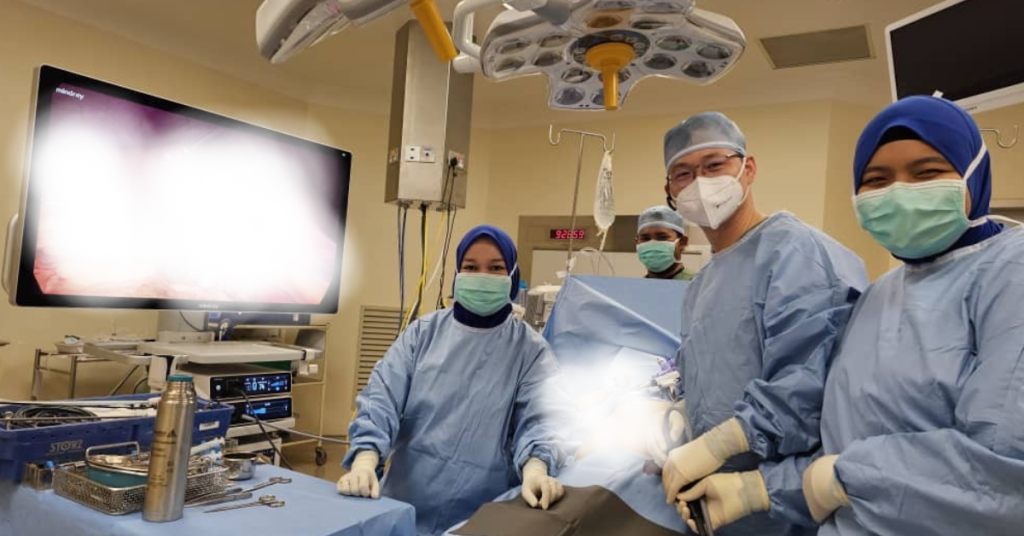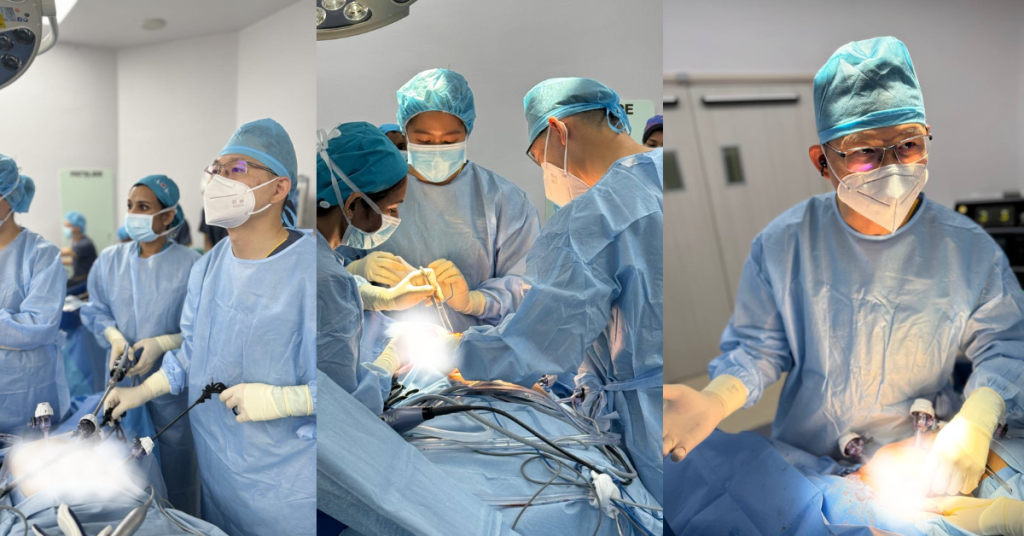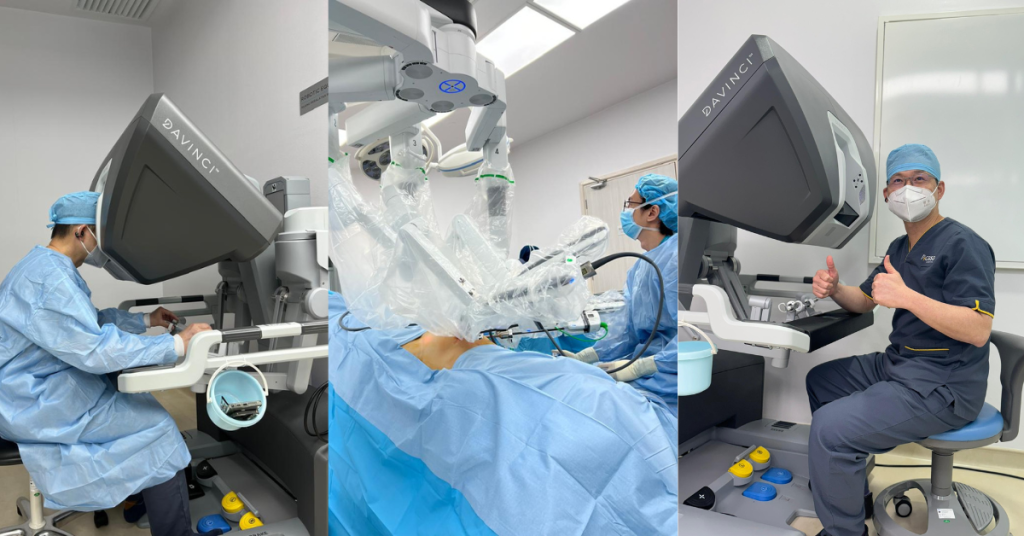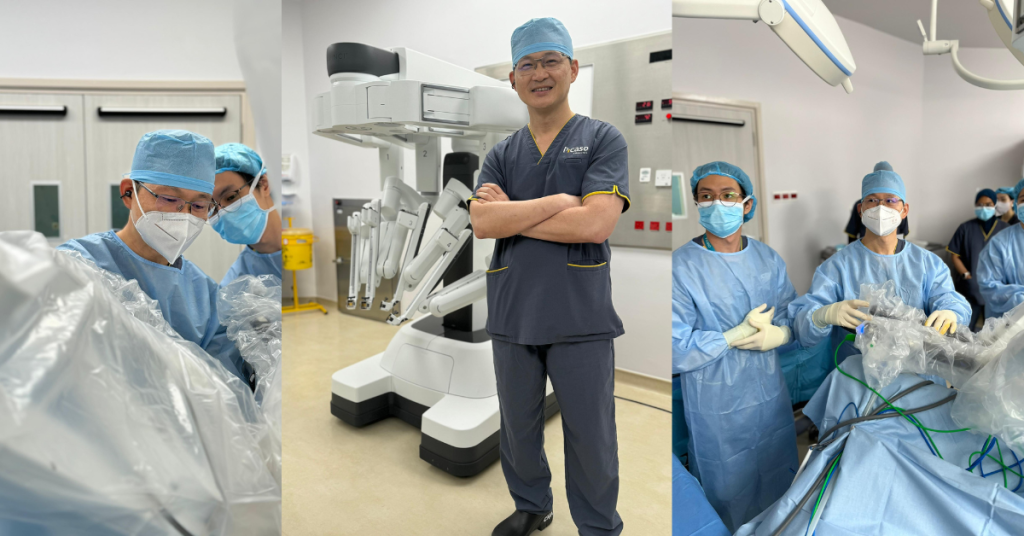“The first time I saw da Vinci’s robotic surgery was in 2003. It was during my postgraduate training in general surgery in Ohio.”
Dr Cha fondly muses.
It was a prototype, displayed in a glass, glinting as the light reflected on the metallic portion of the robotic arms. Dr Cha knew that this would revolutionise healthcare as we know it.
“As I looked at it, all I could think of was, when can I get to use this?”
Fast-forward, it has now become a reality. Dr Cha is one of the leading specialists in the Picasso Robotic Surgery Programme at Picasso Hospital.
The centre is renowned for its expertise in advanced robotic and minimally invasive surgery in the bustling town of Petaling Jaya.
Here, he uses state-of-the-art robotic techniques. It enables his patients to recover faster and with less pain.
The Evolution of Surgery
We have come a long way. The field of medicine and surgery is constantly evolving and progressing, more so now than ever before.
Over 31,000 years ago, the first recorded successful surgery took place – an amputation.
Remarkably, the patient survived the procedure and went on to live for another 6 to 9 years before passing away from unknown causes.
It was considered an extraordinary feat in an era without anaesthesia, sterilisation, or modern surgical tools.
Over centuries, surgeries have been conducted around the globe – in France, Egypt, India, China, Rome and more.
According to medical papyri (ancient Egyptian medical texts), Ancient Egyptians performed minor surgeries, otherwise known as ‘dwa’ (knife-cutting treatments), on swellings and even sutures on wounds.
Meanwhile, in ancient China, physicians used herbal anaesthesia and acupuncture to reduce pain during operations. Han Tuo was the first person documented in China to use anaesthesia in surgery. He devised a blend of wine mixed with mafeisan, or “cannabis boil powder,” to help patients feel more comfortable during operations.
The Greeks, under Hippocrates, laid the foundation for ethical surgical practice. On the other hand, Roman surgeons applied battlefield experience to develop new techniques for treating injuries.

Modern Technology
The evolution of surgical techniques over the past century and a half has been extraordinary.
In the late 1800s, open surgeries were the standard, requiring large incisions that often led to significant pain, lengthy recoveries, and a high risk of infection.
The mid-20th century, from the 1950s to the 1980s, ushered in the era of laparoscopic or “keyhole” surgeries, which used tiny incisions and cameras. This surgical technique reduced patient trauma and sped up recovery times.
The 20th century was also a century of groundbreaking achievements, with surgeons performing the first successful open-heart surgeries, organ transplants like kidneys and livers, hip replacements, and the delicate separation of conjoined twins. These milestones changed the landscape of medicine and paved the way for more surgeries like these.
By the 1980s, robotic surgery was on the horizon, with the first robotic-assisted procedure performed in Vancouver in 1983.
In the early 2000s, the United States Food and Drug Administration (FDA) approved the da Vinci Surgical System, ushering in a new era of precision, safety, and minimally invasive care.
What is Robotic Surgery?
Robotic surgery is rapidly gaining momentum across the surgical world. It is now available in Malaysia.
As the medical field boldly embraces the potential of artificial technology (AI) and cutting-edge technology, the future holds exciting and groundbreaking possibilities. These advancements have the power to revolutionise healthcare as we know it.
What Is It Not?
Robotic-assisted surgery is not surgery done by robots. Robotic surgery is where surgeons use advanced robotic systems to aid in surgeries.
The surgeon is always in control, using the robotic system to achieve greater precision and accuracy. The surgeries are less invasive and easier on patients, too.
‘It (Robotic devices) provides us surgeons a very stable platform to do surgery’, says Dr Cha.
‘It makes visualisations (for us) much better. When you can see better, you operate better.’

Robotic Surgery versus Traditional Surgery
Unlike traditional surgery, the surgeon stands directly over the patient and performs the procedure. In robotic-assisted surgery, the surgeon operates from a console. It can be either seated or standing.
The surgeon has control over the robotic arms and instruments, guiding them with precision throughout the surgery from the console. In traditional surgeries, the surgeon typically makes a large incision to access the area that needs treatment.
However, with robotic-assisted surgery, much smaller incisions are made. It is possible because robotic instruments are precise and compact, allowing them to work in tighter spaces.
The smaller incisions not only minimise damage to surrounding tissues but also reduce the risk of infection. It shortens the time needed for the patient to recover.
Overall, robotic surgery offers a less invasive approach, improving the surgeon’s accuracy and the patient’s experience.
Precision and Control: Why Robotic Surgery is a Game Changer
Surgeons can now perform complex and challenging surgeries with greater precision and control.
‘It gives a 3D visualisation view, similar to open surgery. In the past, laparotomy surgeries were (we could only see surgeries) in 2D, there was no (we were unable to visualise) depth during surgery.’ – Dr Cha
Robotic surgery offers a range of benefits, making it a preferred option for many patients.
One of the advantages is that it’s minimally invasive. The surgeon makes only small incisions rather than large cuts. Less disruption to the body helps reduce the risk of complications during the procedure.
Thanks to the technology, surgeons have a much clearer view of the surgical area, often in high-definition 3D. It allows them to operate with greater precision, even in difficult-to-reach areas that are hard to access with traditional methods.
The increased accuracy also helps reduce the chances of complications during surgery, such as excessive bleeding.

Another key benefit is a quicker recovery. Since the incisions are smaller and there’s less tissue damage, patients usually experience less pain and a shorter hospital stay.
It means they can get back to their daily activities faster. Plus, the smaller incisions mean a lower risk of infection. It leaves behind less noticeable scars.
In summary, robotic surgery offers a safer, more comfortable experience. It has less pain, fewer risks, and faster recovery.
It is a viable option for patients looking to benefit from the latest surgical technology while minimising the impact on their bodies.
Minimally Invasive, Maximally Effective
The overall success rate of robotic surgery ranges from 94% to 100%.
What Happens During a Robotic Surgery?
- Your surgeon will begin by making small incisions to access the surgical site.
- Miniature robotic instruments and a highly advanced, high-definition camera will be inserted into your body through these incisions.
- The camera provides your surgeon with a clear, detailed view of the area being operated on.
- Your surgeon will sit at a console, where they guide the robotic arms with precision and control. These robotic arms can move in tight spaces with greater accuracy than human hands could achieve.
- Throughout the procedure, your surgeon will carefully perform the surgery, ensuring the best possible outcome.
Are there Risks to Robotic Surgery?
Like any surgery, robotic procedures have some risks, though they are generally low. There is a chance of infection or other complications during the surgery.
If any issues arise, your doctor might switch to traditional open surgery to ensure the best result. While nerve injuries are a possibility, robotic malfunctions are rare.
In essence, robotic surgery is safe and similar to potential risks in traditional surgery.
Advanced Technology, Better Care
As the famous saying goes, “The only constant is change.”
In the same way, the medical field is advancing and adapting to new discoveries and technologies.
Healthcare moves forward because of the hard work and dedication of medical professionals. They always strive to improve treatments, perform better surgeries, reduce mortality rates, and enhance the quality of life for their patients.
This progress happens because they are open to learning and adapting to new methods and technologies. Their willingness to embrace innovation makes a difference in patients’ lives, helping them recover faster and live healthier lives.

It’s through these continuous efforts that healthcare continues to improve and evolve for the benefit of everyone.
The moment is here and now!’ Dr Cha enthusiastically proclaims.
‘I can take the Picasso robotic surgery programme to greater heights. Not only in Malaysia but in this region.’
References
- What is Robotic Surgery? https://www.uclahealth.org/medical-services/robotic-surgery/what-robotic-surgery {Last accessed 27 October 2024]
- Robotic Surgery https://my.clevelandclinic.org/health/treatments/22178-robotic-surgery {Last accessed 27 October 2024]
- Robotic surgery https://www.mayoclinic.org/tests-procedures/robotic-surgery/about/pac-20394974 {Last accessed 27 October 2024]
- History of surgery https://en.wikipedia.org/wiki/History_of_surgery#Timeline_of_surgery_and_surgical_procedures {Last accessed 27 October 2024]
- Da Vinci Surgical System https://www.sciencedirect.com/topics/medicine-and-dentistry/da-vinci-surgical-system#:~:text=The%20da%20Vinci%20Surgical%20System%20has%203%20components%3A%20a%20surgeon’s,into%20the%20body%20through%20cannulas {Last accessed 27 October 2024]
- Ancient Egyptian Surgery https://the-past.com/feature/ancient-egyptian-surgery/#:~:text=The%20ancient%20Egyptian%20medical%20texts,and%20the%20reduction%20of%20dislocations. {Last accessed 12 November 2024}
- Legendary Hwa Tuo’s surgery under general anesthesia in the second century China https://pubmed.ncbi.nlm.nih.gov/15666698/ {Last accessed 12 November 2024}